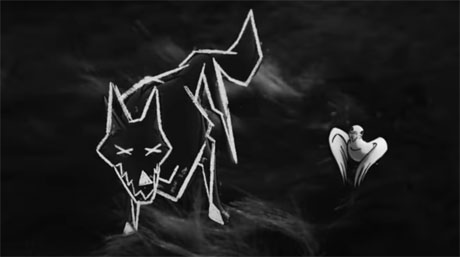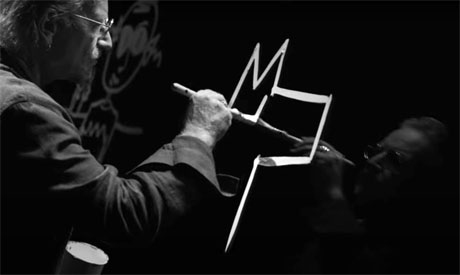
A new half-hour version of Peter & the Wolf, which combines animated characters with live-action backgrounds (and features a special appearance by superstar Bono) is now available on Max. Directors Elliot Dear and Stephen McNally give me a peek behind the curtain at their bold, updated take on a classic. (This Animation Scoop Q&A was edited for length and clarity.)
Jackson Murphy: How do you feel about the power of this short mostly being in black and white, and with select other colors chosen.
Elliot Dear: It was kind of a brave choice but kind of an easy one because we had the source material from Bono’s illustrations, which are monochromatic. Black ink on white paper, with some red spots throughout. We were keen to maintain fidelity to that original artwork so that he would recognize it and people who had seen the original book would recognize it too. Ultimately we ended-up with something unique.

JM: It is very unique. Stephen, when you saw Bono’s illustrations for the first time, what kind of impact did it give you?
Stephen McNally: A powerful one. First off, I thought it was going to be very hard to animate. It was quite a process of adapting them. But I was excited. They’re full of energy and excitement. And there’s quite a darkness to them, for something that’s ostensibly for a younger audience. It was a very exciting challenge to adapt.
JM: You guys pull it off. The way you [present] this live-action/animation combo is really cool. It’s really interesting. Elliot, what was the approach of the live-action backgrounds with these animated characters? I think the way the movement goes is pretty unique.
ED: Okay. I’ll show you something not many people get to see, Jackson. These are our animation stand-ins. (laughs) They’re very crude… and represent the proportions of our characters from the character design and model sheets. We had storyboards to work off for shooting the live-action miniatures. But of course the animators wouldn’t have any character within that to see for scale or for lighting reference. So that’s what these guys are. They provide reference for shadow and scale. We were switching lenses — 24mm probe lenses and 85mm longer lenses. That changes the perspective on a character. To save an animator from having to guess what that character would look like through that particular lens we would leave these in for one pass and provide it as a reference. We would shoot a clean pass (a “beauty pass”) afterwards to composite into. These guys are super helpful.

Elliot Dear
JM: Thank you for showing me those. And Stephen, the angles are really interesting.
SM: We took a lot from live-action filmmaking to bring into this. Quite a lot of our things were from German expressionist films and “The Night of the Hunter” — the starkness and the theatricality. Our storyboarders really got to push the angles quite a lot. We prepped it with 3D models so we could roughly figure out, “Is the camera gonna work there when we finally get to the shoot?” A couple other shots — the stranger camera angles — were just improvised on the set. Elliot had a really bright lightbulb idea of moving [a certain] way to get all those camera angles at once and stitch them together into one shot… and you get a better bit of cinematic storytelling.
JM: Elliot, how did you want the personalities of these characters to shine?
ED: The animals are represented by different instruments. And they also kind of represent aspects of Peter’s character — his personality. The playfulness of the bird or the silliness of the duck or the maturity of the cat. The wolf represents his fear of the unknown. And Grandfather represents a desire to stay fixed and not change — and to hold onto the past and grief.

Stephen McNally
SM: It speaks to me very strongly. Peter is angry and alone and in the story it starts with Peter living with his grandfather in this cottage. We came to our grief aspect on it and asking, “Why is Peter living with his grandfather in this cottage?” That kicked us off onto how their relationship was. There’s initially a real disconnect between the two. Peter is angry and sad and roiling with emotion, while Grandfather is just trying to keep a lid on everything and his own emotions — keep it all bottled up inside him. He’s making little ships and bottles because he’s bottling his emotion.
ED: That is on purpose.
SM: By the end of the piece, they come to see eye to eye a little bit more. They see where the other one’s coming from.
JM: Elliot, you touched on the music. There’s this timing effect. It’s so well done. How challenging was it making sure the timing was successful?
ED: It certainly was a challenge — making sure the pace was maintained. Stephen was so in touch with the 2D animation team.
SM: The whole time they were boarding they were listening to a piece of music that they were drawing to, so that they were all responding to the pacing and the rhythms of the timing. It helped dictate how the action played out. Even our cutting rhythm was very much dictated by how the music flows. It is a musical. It’s a drama and a heist/action movie and a slapstick comedy at times, but it’s also a musical under all of that. You have to respond to what the music’s doing.

JM: Yes. It is all of those things. Gavin Friday’s narration… his grittiness and the commanding nature of his voice feels right. What does his narration do for the source material and what you want to accomplish with this?
ED: Gavin’s got a great sounding voice. He gives gravity to the piece. It’s very grown up. It’s an authoritative sound and very much a storyteller’s voice that’s very nice. We offset that by making him a fly character, which has comedy to it. That was a lot of fun to play with it. Ultimately the project is his baby, really. It’s nice that he got to see it through in that way and for him to be so present in the final piece.
JM: Yeah. I love that there’s a book component to this. Stephen, the short opens with Bono doing the paintings. I wonder, since he’s so used to being on stage (now in a sphere) in front of audiences performing… was he nervous at all about painting in front of the camera, or did he feel at-ease?
SM: He was very humble about his painting, actually. His humility came through quite a lot, which surprised me a little bit, being a star at that level. He was very kind and helpful on set. Elliot did most of the telling him what to do.
ED: Yeah. We tried to strike a balance between achieving some more technical shots… that transition from Bono to Peter being the main one. That actually required some timing. He was very receptive to the direction. He actually had to touch the brush onto the glass at a very specific point during that camera movement, and I think it took us four or five [tries]. He took direction well and repeated that several times. I think we got it on the fourth go. He was very patient. We let him do his thing. It was my job to operate the camera and try to capture that. There’s actually a lot of footage. We cut it down for the intro. He was nice to work with.

JM: Maybe more of that video will end up on social media. I think people would be interested in seeing that. For both of you, how do you feel about the concept of classic stories feeling new again? To me, that’s what this is.
ED: Hopefully this will speak to some people. It doesn’t have to speak to every single person. It doesn’t have to be everyone’s favorite [version]. But I think we’ve put a fresh spin on it. We’ve tweaked the themes. We’ve added story elements to it and have tried to make it fresh so that it’s relevant for audiences today.
SM: There’s a lot to be said about re-examining old stories. Telling new stories through the structures and framework of an old story lets you see an old story in a different way, but it doesn’t erase the story that’s come before. You can still watch every other version of “Peter & the Wolf” and this one, which does something different. There’s not as much point if you’re telling an old, classic story if you’re not going to add your own little bit to it. You’ve got to feel like you’re contributing something to that story.
ED: But it’s important that there’s not a sense of one-upmanship or competition (“Who can do the best version of Peter & the Wolf?”). I don’t think it’s about that. It’s a different offering.
SM: It feels like being able to work in a tradition, rather than trying to override something.
- INTERVIEW: Strap In For “Mars Express” - April 30, 2024
- INTERVIEW: Jeff Fowler On “Knuckles” And “Sonic 3” - April 22, 2024
- INTERVIEW: “Inside Out 2” Director And Producer On Pixar Sequel - April 16, 2024


 October 19th, 2023
October 19th, 2023  Jackson Murphy
Jackson Murphy  Posted in
Posted in  Tags:
Tags: 






